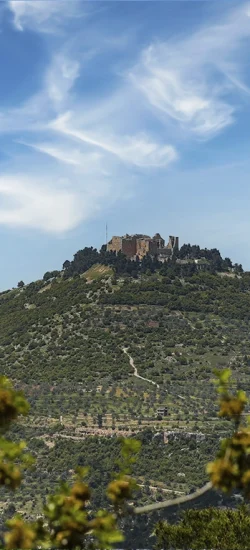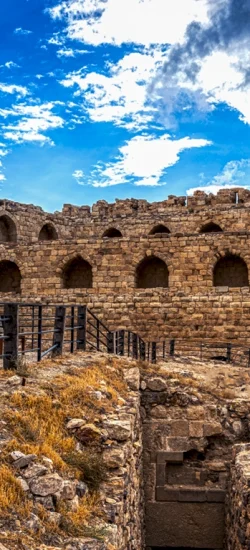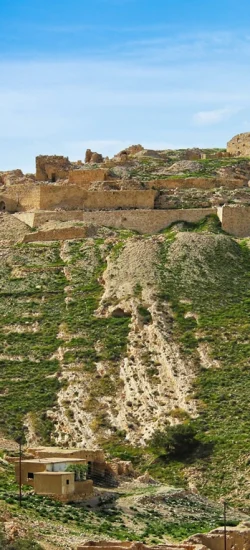Crusader Castles
Crusader Castles
For those fascinated by the Crusader Legends and Lore, a second group of castles beckons. The scenic Kings’ Highway is littered with the remains of Crusader forts and outposts. The most important among these are Karak and Showbak – fascinating examples of architectural and military traditions of the time. Their galleries, towers, chapels and ramparts still echo with the resolve of the Crusaders who built them almost a thousand years ago.
Ajloun Castle
The marvels of nature and the genius of medieval Arab military architecture have given northern Jordan two of the most important ecological and historical attractions in the Middle East: the sprawling pine forests of the Ajlun-Dibbine area, and the towering Ayyubid castle at Ajlun, which helped to defeat the Crusaders eight centuries ago.
Ajlun Castle (Qal’at Ar-Rabad) was built by one of Saladin’s generals in 1184 AD to control the iron mines of Ajlun, and to deter the Franks from invading Ajlun. Ajlun Castle dominated the three main routes leading to the Jordan Valley and protected the trade and commercial routes between Jordan and Syria; it became an important link in the defensive chain against the Crusaders, who, unsuccessfully spent decades trying to capture the castle and the nearby village.
The original castle had four towers, arrow slits incorporated into the thick walls, and was surrounded by a moat averaging 16m in width and up to 15m deep.
In 1215 AD, the Mameluk officer Aibak ibn Abdullah expanded the castle following Usama’s death, by adding a new tower in the southeast corner and a bridge that can still be seen decorated with pigeon reliefs.
The castle was conceded in the 13th century to Salah ed-Din Yousef Ibn Ayoub, ruler of Aleppo and Damascus, who restored the northeastern tower. These expansion efforts were interrupted in 1260 AD, when Mongol invaders destroyed the castle, but almost immediately, the Mameluk Sultan Baybars re-conquered and rebuilt the fortress.

Al Karak Castle
Whether you approach Karak from the ancient Kings Highway to the east or from the Dead Sea to the west, the striking silhouette of this fortified town and castle will instantly make you understand why the fates of kings and nations were decided here for millennia.
An ancient Crusader stronghold, Karak sits 900m above sea level and lies inside the walls of the old city. The city today is home to around 170,000 people and continues to boast a number of restored 19th century Ottoman buildings, restaurants, places to stay, and the like. But it is undoubtedly Karak Castle that dominates.
The town is built on a triangular plateau, with the castle at its narrow southern tip. The castle is some 220m long, 125m wide at the north end, and 40m wide at the southern end where a narrow valley deepened by a ditch separates it from the adjoining and much higher hill – once Saladin’s favourite artillery position. Throughout the castle, dark and roughly-shaped Crusader masonry is easy to discern from the finely-crafted blocks of lighter and softer limestone used in later Arab work.
While the castle we see today essentially dates back to the 12th century, Karak has been a fortress since biblical times. The Bible relates how the King of Israel and his allies from Judah and Edom ravaged Moab and besieged its king Mesha in the fortress of Kir Heres, as Karak was then known.
Centuries later, it took the Crusaders some twenty years to erect their vast castle. Once finished in 1161, it became the residence of the lord of Transjordan, by then the most important fief of the Crusader kingdom, rich in produce and tax revenues. After withstanding several sieges in the early 1170s, Karak came under the rule of Reynald of Chatillon, a lord who became known for his recklessness and barbarism. Breaking all treaties, he began looting merchant caravans and Mecca-bound pilgrims, attacked the very homeland of Islam – the Hijaz – and raided Arabian ports on the Red Sea, even threatening Mecca itself. Saladin, the ruler of Syria and Egypt, reacted swiftly. He took the town of Karak by force, burned it down and almost managed to storm the castle as well.
Reynald’s peacetime robbery of a large caravan in 1177 prompted fast retribution from Saladin – who attacked the Crusader kingdom – ending in the defeat of the Crusader army at the Battle of Hattin. Saladin spared most of the captives except Reynald, who he executed himself. The defenders of Karak held out for eight months in a prolonged siege before surrendering to the Muslims who, mercifully, allowed them to walk free.
Once again in Muslim hands, Karak became the capital of a district covering much of Jordan, playing a central role in Middle Eastern politics for the next two centuries. For a time, Karak even became capital of the whole Mameluk kingdom when Sultan an-Nasir Ahmad grew weary of power struggles in Cairo. Indeed, it took eight separate sieges before his brother and successor as-Salih Ismail took the fortress and returned the royal insignia. It was during these sieges that Karak had the dubious honour of being the first target of modern artillery in the Middle East, as-Salih Ismail making use of cannons and gunpowder.
Under the Ayyubids and early Mameluk sultans, the castle was substantially renovated and the town’s fortifications strengthened with massive towers but seemingly no gates – access to the town was through subterranean passages with entrances still visible today.
In later times, the town more often than not became a refuge for rebels, while the castle was used as the gathering place of tribal councils. Firm Turkish administration was enforced after 1894 and the Mameluk palace inside the castle was used as a prison. The Great Arab Revolt dealt the last blow to Turkish rule, which ended in 1918.

Al Shobak Castle
Al Shobak Castle Built in 1115 AD by Baldwin I, who later built Karak, it was originally known as Mont Realis (Montreal) and was the first outpost of the kingdom of Jerusalem in the Crusader district of Outrejordain.
Situated on an isolated knoll overlooking the trade routes that ran through the wadi below, Shobak is breathtaking.
The original entrance to Shobak Castle was through a dog-legged triple gate. Above this is the Crusader Church, with strategic views of the old village. There are several wells found within the castle walls, although the main water source was the spring at the foot of the hill. One of the treasures of this site is secret passage of over 350 steps that goes down to the spring, ensuring that during times of siege, the castle would have access to adequate supplies of fresh water. Baldwin l’s court, a large room with antechambers running around it, has been partially reconstructed. Other rooms hold olive presses and a second church. It is still possible to see the cisterns, baths and pipes for harvesting rainwater. Shobak fell to Saladin in 1189. In the 14th century the Mamluks took the castle and renovated it. Many of the outer walls now feature beautiful Kufic and Quranic inscriptions. The Mamluks built a watchtower and used the court as a school. Below Shobak is a shrine to Abu Suleiman al-Dirany. Women still come here today and leave handprints in henna as a request for children and for the sick to become well. Some experts believe that the shrine was built by the Mamluks.
Shobak’s daunting position made it a strong sentinel during the 12th century. The visible bones of the castle provide a startling insight into its anatomy, both as a Crusader castle and as a Mamluk edifice. Today, it is a wonderful, romantic destination. The tranquility of the site, and its magnificent views, allow for peaceful reflection.

Vaux Moise Castle
aux Moise (Al Wu‘eira) is a small crusader castle founded by Baldwin I of Jerusalem in 1116 as an outpost of the larger crusader castle at Shobak (Montreal), to control the trade and communication route between Cairo and Damascus. It stands on a narrow ridge with smooth sides by the well-watered valley of Wadi Musa, just outside the ancient city of Petra.
The surviving building is all twelfth-century work and is quite remarkable in its construction. In the wilderness of lumpy, weirdly eroded rocks, the Crusaders chose a ridge separated from the surrounding massif by sheer precipices. They improved this isolation by smoothing the rocks so that an attacker could not possibly find any hand or footholds. The only access was across a single narrow bridge, completely overlooked by the walls of the castle. Guarding this bridge stands the most remarkable architectural feature of the defences, a gatehouse carved out of the solid rock. The red sandstone of nearby Petra is, of course, famous for its rock-cut buildings. Whether knowingly or not, the Crusaders followed the ancient tradition and hollowed out a gatehouse cave, complete with benches along each side.
Al-Habis Castle
edge- and cave-fortresses are not usually included in the typologies of Crusader castles because they rely almost entirely upon their natural locations for defence, with man-made structures playing a secondary role. A good example of such fortifications is Castle Al-Habis (Cave de Sueth) built by the Crusaders in 1115 AD. Measuring 156,5 m by 74 m, the fortress was difficult to access, providing reinforced protection from attacks which played a significant role in the military control of Petra during this period.
The Cave de Sueth was often raided, attacked or besieged, and fell to one side or the other several times. Unfortunately, the site is also very vulnerable to earthquakes and has suffered severe damage during its recorded history, both before and since the Crusader period. As a result, most of the cliff face has collapsed into the deep valley of the River Yarmouk. Nevertheless, several man-made caves survive: some are still complete, others have only partial remains, and a few are only visible now as recesses in the cliff.
The history of this cave-fortress begins with the Crusaders’ fortification of the lower Yarmouk valley in 1105. The invaders knew the area as the Terre de Suethe, from the Arabic word sawad meaning ‘cultivated zone’, in contrast to the semi-desert further east. That same year the area was ravaged by the ruler of Damascus, who also destroyed a new Crusader outpost on the Golan Heights. Instead of provoking further retaliation by building a castle on the Heights, the Crusader Prince of Galilee garrisoned the naturally defensible site of the Cave de Sueth on the southern side of the river, primarily as an observation post.